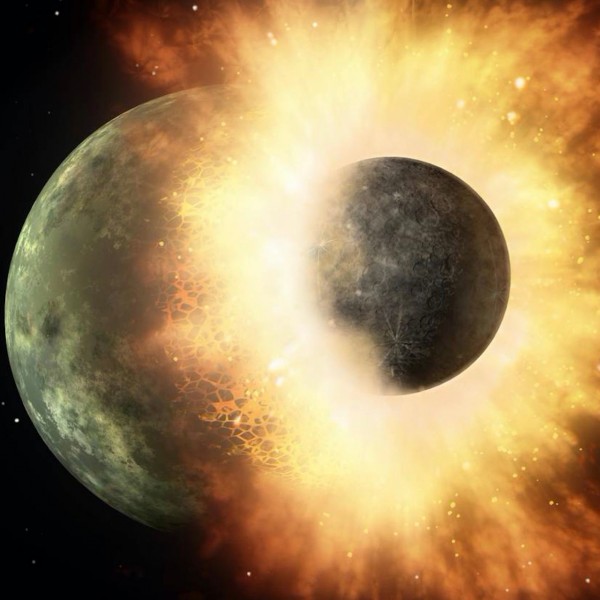
Impacts – collisions with flying debris, early in the history of our solar system – are thought to have been vital to the evolution of life here. Earth impacts appear to have driven mass extinctions. One giant impact is thought to have created our moon, whose ebbing and flowing tides may have helped jump-start earthly life. Is Earth typical for its impacts? For its moon? For its life? We can’t answer those questions, but a new study does suggest that Earth’s impact history is “fairly typical” for Earth-sized planets. It suggests that the average Earth-like exoplanet is likely to have experienced a giant impact, with roughly the energy thought to have formed our moon.
Elisa Quintana at NASA’s Ames Research Center led the study. Her team performed advanced computer modeling of the inner solar system, where the rocky planets like Mercury, Venus, Earth and Mars orbit our sun. The modeling included what’s called fragmentation, the tendency of colliding bodies to break up into more and smaller bodies, rather than sticking together to form planets and moons.
As Quintana’s statement explained it, fragmentation is “very computationally intensive.” And so it’s often ignored in computer modeling. But her team did include it in their computer simulations of forming solar systems, running 140 simulations with and 140 without the effects of fragmentation. Their fragmentation-inclusive simulations resulted in 164 Earth-analogs, that is, simulated worlds similar to Earth. These scientists’ statement went on to explain:
Quintana and collaborators then used the fragmentation-inclusive simulations to examine the collisional histories of Earth-like planets that form. Their goal is to understand if our solar system’s formation and evolution is typical or unique.
Among the 164 computer-generated Earth-analogs, Quintana and collaborators found that impacts large enough to completely strip a planet’s atmosphere are rare; fewer than 1% of the Earth-like worlds experienced this.
But giant impacts that are able to strip approximately 50% of an Earth-analog’s atmosphere — roughly the energy of the giant impact thought to have formed our moon — are more common. Almost all of the Earth-analogs in the computer simulation experienced at least one giant impact of this size in the 2-billion-year simulation. The average Earth-like world in the simulation experienced approximately three such impacts. Their statement concluded:
These results suggest that our planet’s impact history — with the moon-forming impact likely being the last giant impact Earth experienced — is fairly typical for Earth-like worlds.
Thus the process of world-building itself may contribute to life’s evolution. That is, the study shows that giant impacts are common among Earth-like worlds. We already know of at least one case – the case of our Earth – where a giant impact apparently formed a large moon.
And it’s thought that our world’s large moon, plus smaller impacts occurring more frequently, played a role in how life here arose and evolved. Maybe the same is true on other, distant worlds.

Bottom line: An advanced computer simulation led by Elisa Quintana of NASA’s Ames Research Center suggests that newly forming Earth-like worlds are likely to suffer a giant impact, like that thought to have created our moon.











